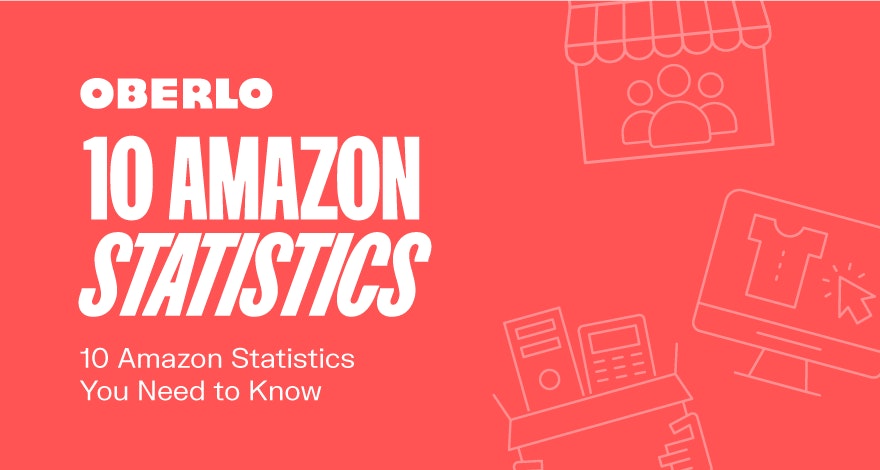The year was 1994 when Bezos quit his job and launched Amazon out of his garage. In 1995, the first item was ordered online on Amazon – a book. In the first month of its launch, Amazon had already sold books to people in all 50 states and in 45 different countries. Within 30 days, it had generated $20,000 per week in sales.
In the 25 years since Amazon was launched, it holds the title of the world’s largest online retailer and has become a household name.
Amazon has become synonymous with online shopping. And it continues to grow by developing new products, acquisitions, and various different service offerings that continue to enlarge its customer base. Amazon has broadened its target market to try to cover as many customers as possible. And it’s doing a great job, because there seems to be something for everyone on Amazon. As online shopping becomes increasingly popular, people turn to Amazon for just about everything, whether that’s everyday groceries or seasonal gifts.
So if you’re looking for ideas to sell on Amazon, or you need some inspiration to build your own ecommerce store, check out our Amazon guide that can teach you step by step tactics of how you can get sales on Amazon.
Here are the top 10 Amazon Statistics that you need to know about in 2023.
Post Contents
- 1. The Popularity of Amazon
- 2. Customers Trust Amazon
- 3. Number of Amazon Prime Members
- 4. Amazon Revenue
- 5. The Most Popular Amazon Product Category
- 6. Most Important Factors Driving Purchasing Decisions on Amazon
- 7. Amazon Usage by Device
- 8. Number of Items Sold on Amazon per Minute
- 9. Number of Sellers on Amazon
- 10. Buyers Visit Amazon for Inspiration
- Summary: Amazon Statistics 2023
- Want to Learn More?



1. The Popularity of Amazon
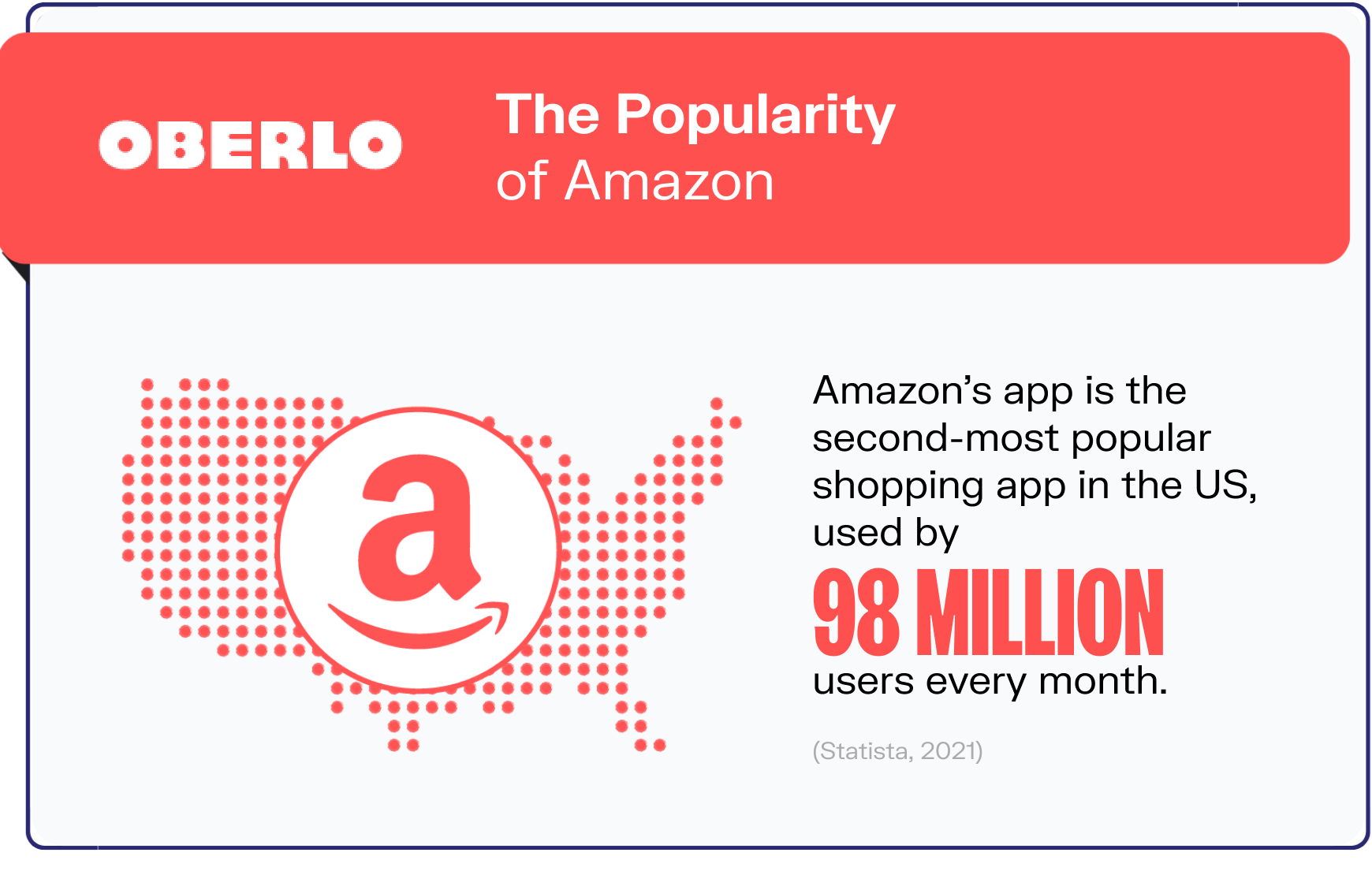
The popularity of Amazon is indisputable, and the numbers say it all. The Amazon app is one of the most popular shopping apps in the United States, with 98.07 million users accessing it at least once a month (Statista, 2021). This puts it just behind Walmart’s shopping app, used by 120 million people every month.
→ Click Here to Launch Your Online Business with Shopify
The usage of Amazon’s app also outranks Target’s by a mile. In comparison with Amazon, just 17.12 million people shop on Target’s app each month.
Mobile commerce has become extremely popular among online shoppers. In fact, mobile retail sales in the US are expected to hit $431 billion in 2022. This may be because of the seamless experience that shopping apps are committed to providing their customers. It’s becoming so simple and stress-free to shop online. This also adds to the fact that customers can purchase their favorite products on the go. They don’t need to be in front of a desktop computer to be shopping online.
To give credit to Amazon, it has revolutionized online shopping for customers. It has made the shopping experience incredibly smooth. You can order just about anything on Amazon. And another factor that weighs in favor of Amazon is that it has built a strong relationship with its customers. But more on that later.
2. Customers Trust Amazon
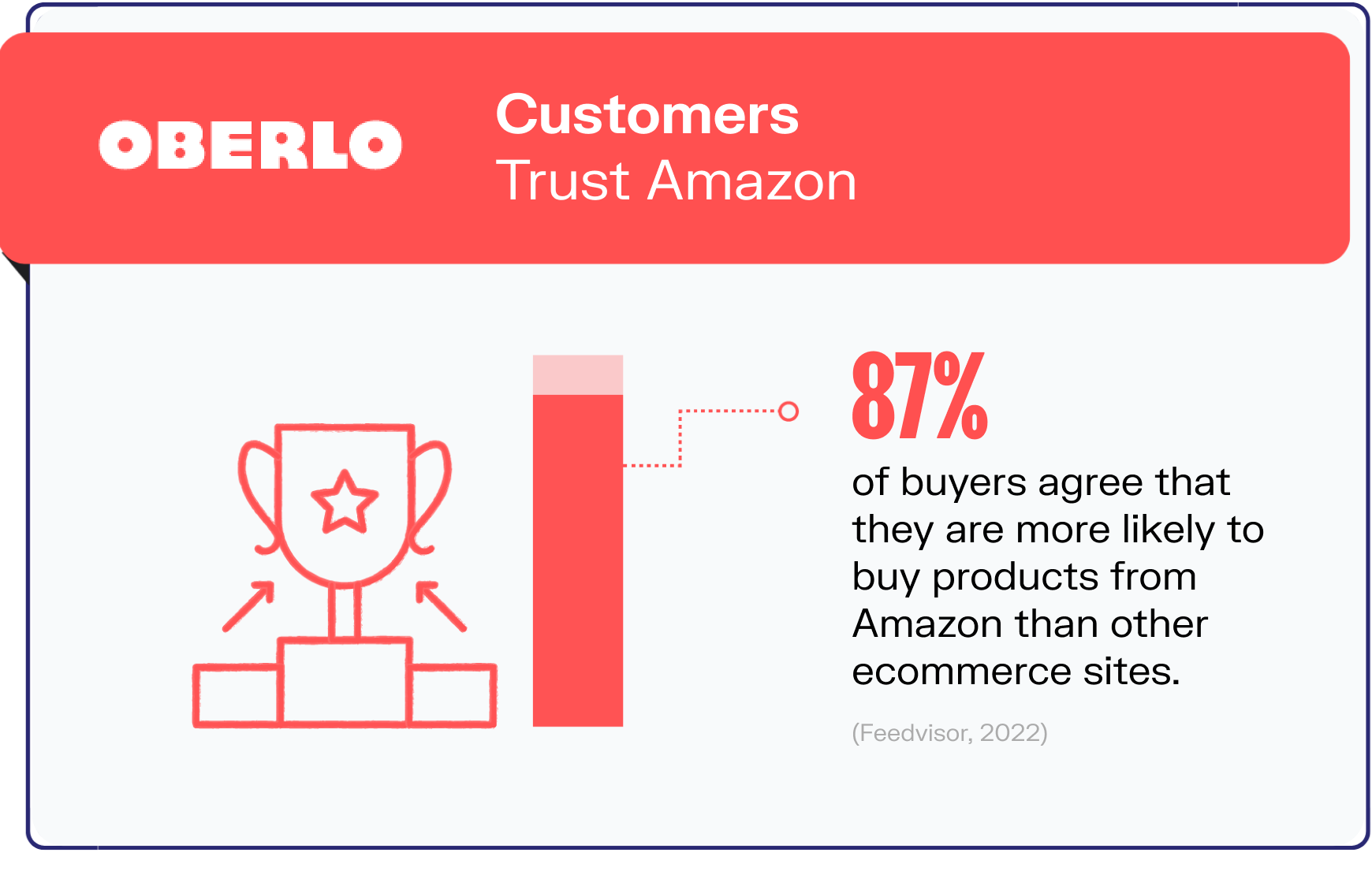
Customers trust Amazon—and for good reason. Based on a survey of more than 2,000+ US customers, 87% of buyers agree that they’re more likely to buy products from Amazon than from other ecommerce sites (Feedvisor, 2022). There’s no denying that Amazon is at the center of ecommerce. This point particularly held true for customers who purchase products online regularly. In fact, 53% of Amazon shoppers purchase something at least once a week, and as many as one in 10 say they do so every day.
Gaining customer trust is a stepping stone toward becoming successful as a company or brand. The trust that Amazon has built with its customers is based on consistent and transparent product experiences. Forbes has famously said, “Amazon has earned our trust by delivering the products we want, on time, intact, in the same branded brown boxes—consistently.”
So, if you have a brand or business, you should be thinking about developing customer relationships. Customer relationships will help you win more shoppers. In the age of online shopping, by focusing on truthful and clear product information online you can deliver a consistent experience to your customers. Brands should focus on building trust with their audience by providing them with the right content, encouraging reviews, and providing high-quality customer service, which will help customers trust your brand in the long run.
If you want to learn how to sell on Amazon, check out this guide.
3. Number of Amazon Prime Members
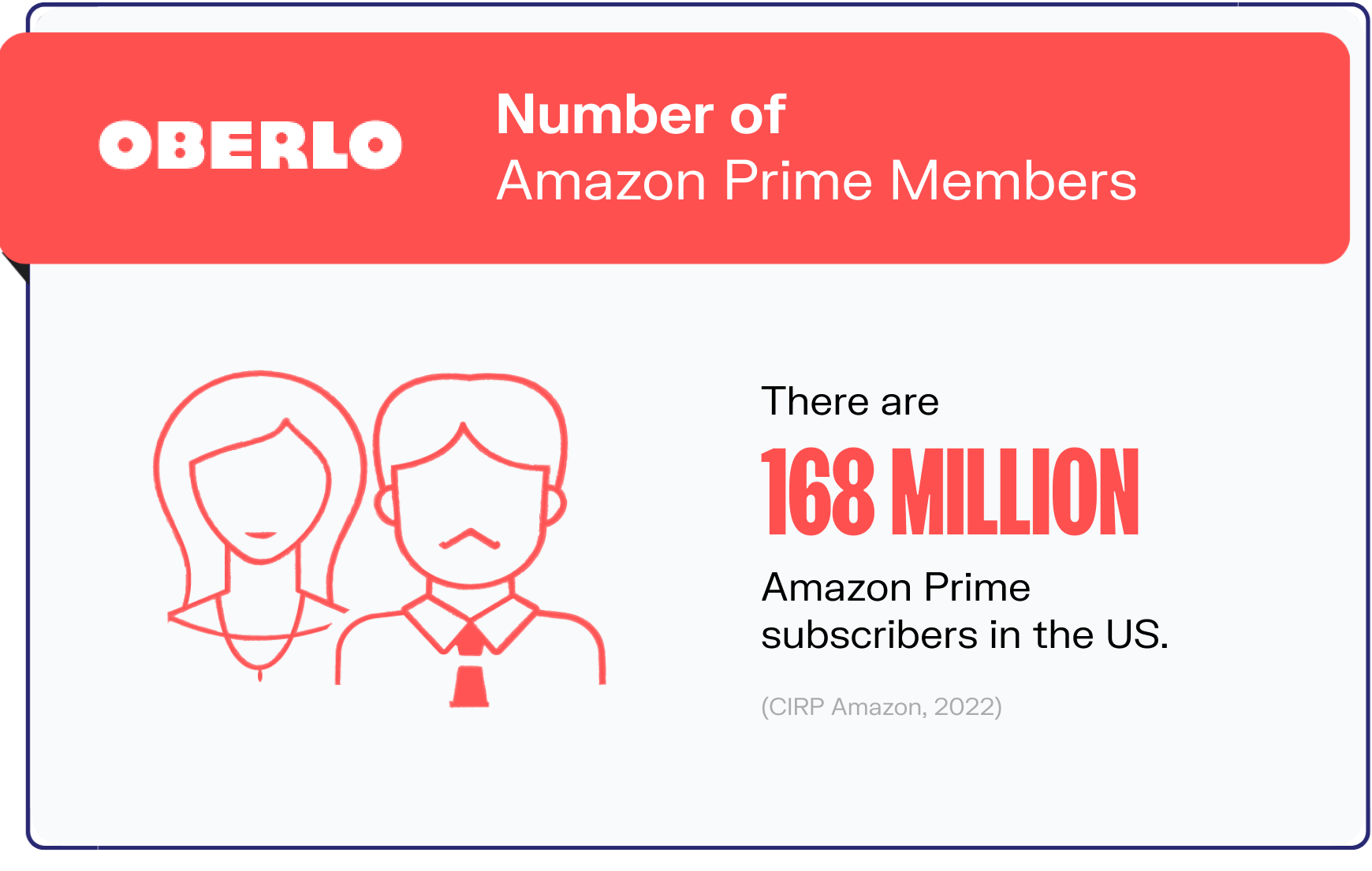
Amazon’s Prime membership program continues to reach an increasing number of online shoppers. There are currently 168 million Prime subscribers in the US (CIRP Amazon, 2022).
Amazon Prime is a paid subscription service offered by Amazon. The program was launched in 2005 and is available internationally. The subscription includes services such as free two-day (or faster) shipping, music and video streaming, and exclusive and early access deals to subscribers. For regular online shoppers, the benefits of Amazon Prime are undeniable.
Even though reports say the growth in Amazon Prime subscribers has plateaued in recent years, it still represents a massive increase over the past decade. In 2013, there were just 17 million Prime subscribers. This essentially means that the number of Amazon Prime members has risen 10-fold in 10 years.
Prime users also represent an important part of Amazon’s sales. Data also shows that it’s this group of users that are shopping more on Amazon now than they were a year ago.
4. Amazon Revenue
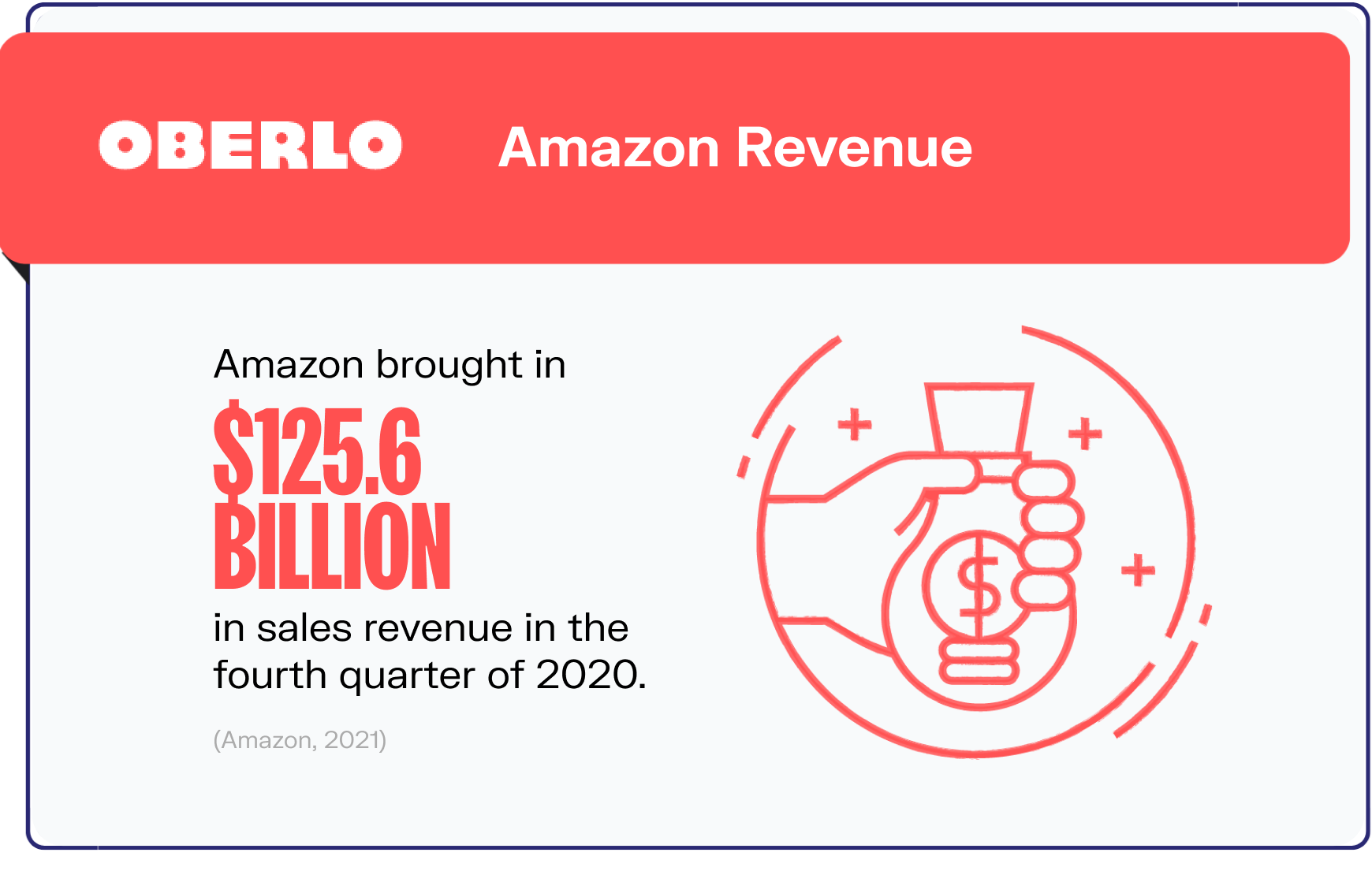
As global ecommerce sales continue to grow, it should come as no surprise that as the top ecommerce company in the world, Amazon’s revenues reflect similar growth.
The latest fiscal numbers from Amazon show that the company made $125.6 billion in sales revenue in the fourth quarter of 2020 (Amazon, 2021). This marks an impressive 44% year-over-year increase.
Of Amazon’s Q4 2020 revenue, net income constitutes $7.2 billion, more than double the previous year’s figures.
The bulk of Amazon’s sales continues to come from North America. Sales from the region totaled $75.3 billion (a 40% annual increase), compared to the $37.5 billion the company generated from international sales.
Looking ahead, the company is estimating increased sales for the first quarter of 2021. It has forecast a year-over-year growth of between 33% and 40% to hit between $100 billion and $106 billion in net sales.
5. The Most Popular Amazon Product Category
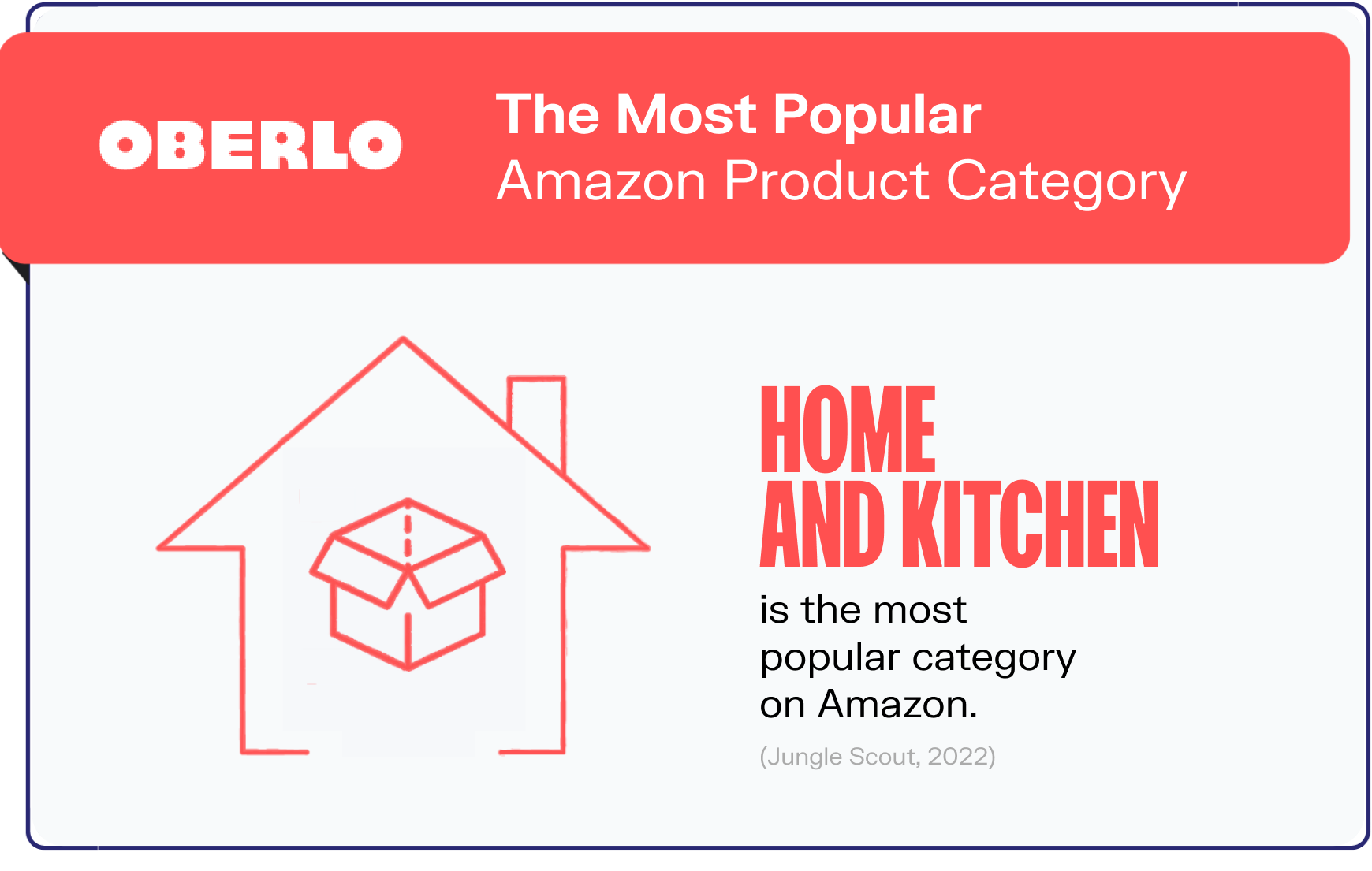
Out of all the product categories, home and kitchen is currently the most popular product category for businesses selling on Amazon. Nearly one-third (32%) of all small and medium-sized businesses on Amazon list products in this category (Jungle Scout, 2022).
The second-most popular category is beauty and personal care. Products in this category are sold by 23% of SMB businesses on Amazon.
Amazon is constantly working on increasing its product and category coverage on the platform. This means that it’s also growing to attract new types of customers and various different niches.
The diverse range of products offered by Amazon is one of its core strengths that sets it apart from its competitors, and also why so many other companies face difficulties in achieving the same level of success.
Expanding its categories also means that it’s becoming accessible to new audiences and constantly expanding its target market to reach as many individuals as possible. Amazon does all this while maintaining quality standards, which builds trust.
6. Most Important Factors Driving Purchasing Decisions on Amazon
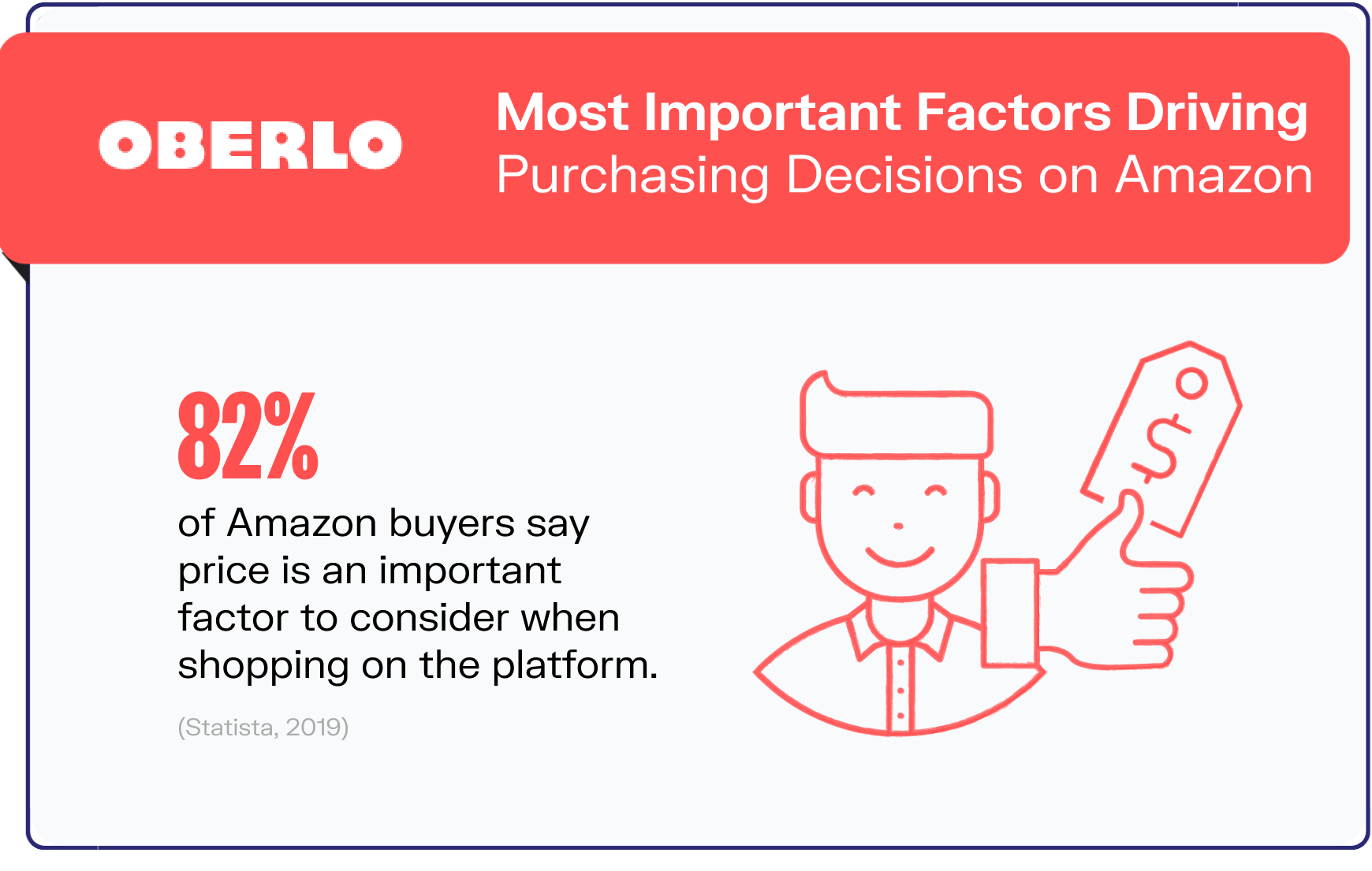
It’s clear that consumers love shopping on Amazon. But what is it that drives their purchasing decisions when browsing on the ecommerce platform?
Survey results show that price is the leading factor of purchases on Amazon, with 82% of Amazon buyers listing it as an important shopping consideration (Statista, 2019).
This is followed by low shipping costs and positive product reviews, which are considered to be key factors by 70% and 57% of Amazon buyers respectively.
Many of them also enjoy the flexibility offered in returning products and the quick shopping time that Amazon offers. Just under half of all Amazon buyers say these are important factors to think about when online shopping on Amazon.
Though Amazon’s Prime program is booming, it’s far from being a deal-breaker for shoppers who are deciding between products, with just over one-third (35%) of them saying Prime eligibility is a key factor they consider.
7. Amazon Usage by Device
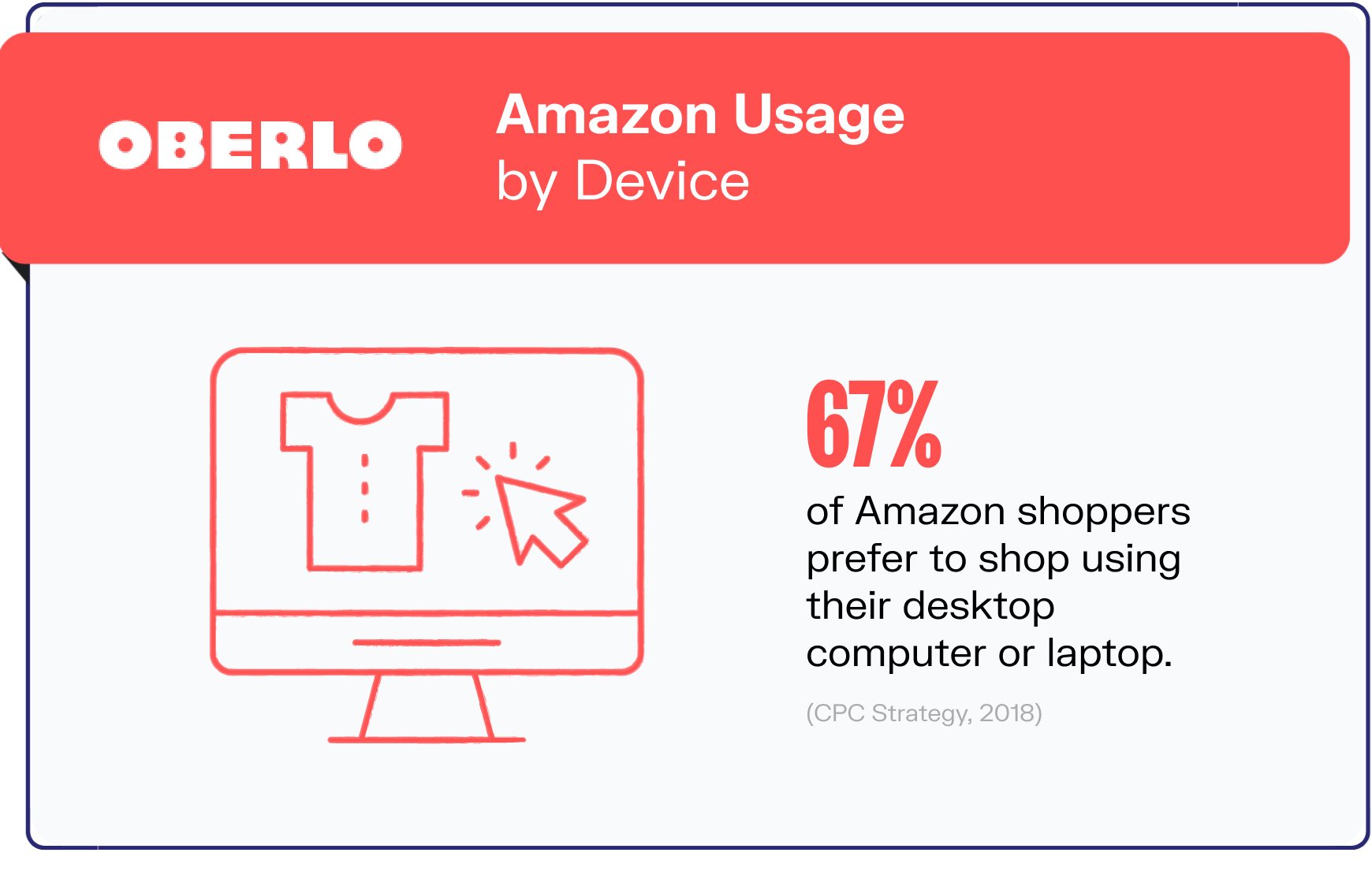
Even though the tech world is increasingly adapting to being mobile-first, online shoppers using Amazon still prefer desktop over mobile when they’re making a purchase. 67% of Amazon Shoppers prefer to shop using their desktop computer or laptop (CPC Strategy, 2018). In comparison, 24% of shoppers preferred to shop using mobile devices. This statistic shows us the types of devices used by online shoppers in the United States when shopping on Amazon. Amazon Echo (voice-enabled device) had the lowest reported usage rate. But the real question remains as to why this is the case. And what could this Amazon stat tell us about the future of online shopping?
To begin with, there’s a difference in the device preference when it comes to different age groups. Those that are 35 and younger have a clear preference for mobile devices, whereas online shoppers of 55 and over preferred to use desktop or laptop devices. Another thing to note here is that this statistic points out device usage based on purchase action. This may not seem like a noticeable difference at first, but other studies have shown that shoppers are more likely to browse on mobile and buy on desktop. So, when it comes to the future of online shopping, mobile will continue to be an important step in Amazon’s buyer journey, helping shoppers smoothly transition from the browse to buy stage. Additionally, current investments in AR (Augmented Reality) and app updates that are catered toward faster purchases (such as swipe-to-buy) are hints in the direction of ease for the online shopper.
8. Number of Items Sold on Amazon per Minute
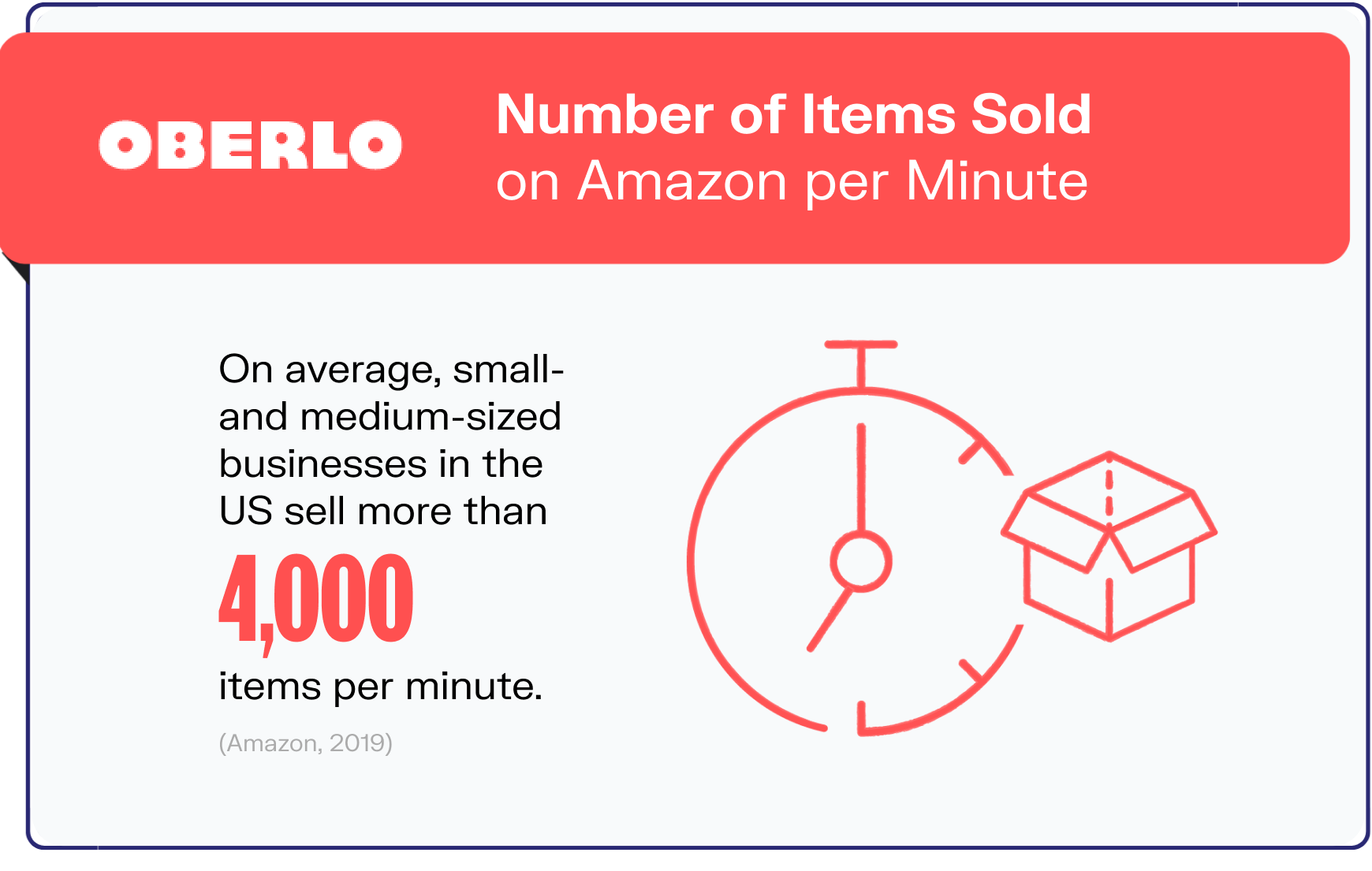
Millions of SMBs (small- and medium-sized businesses) from around the world are working with Amazon. And this next statistic shows us why. On average, SMBs located in the US sell more than 4,000 items per minute (Amazon, 2019). It’s interesting to note that more than half of the items sold on Amazon’s stores worldwide are from SMBs. That’s just one measure of the success that SMBs are achieving by working with Amazon.
It’s safe to say that Amazon offers a huge opportunity for SMBs to flourish. SMBs selling through Amazon’s stores have created an estimated 1.6 million jobs worldwide. In order to encourage and help SMBs thrive in Amazon stores, Amazon also hosts a variety of events to educate sellers. This includes the Amazon Academy events across Europe, the Boost Conference specifically for businesses using the FBA service, and the new Selling Partner Summits across the US. The new Selling Partner Summits are a series of six conferences designed to help sellers grow their business in Amazon’s stores.
9. Number of Sellers on Amazon
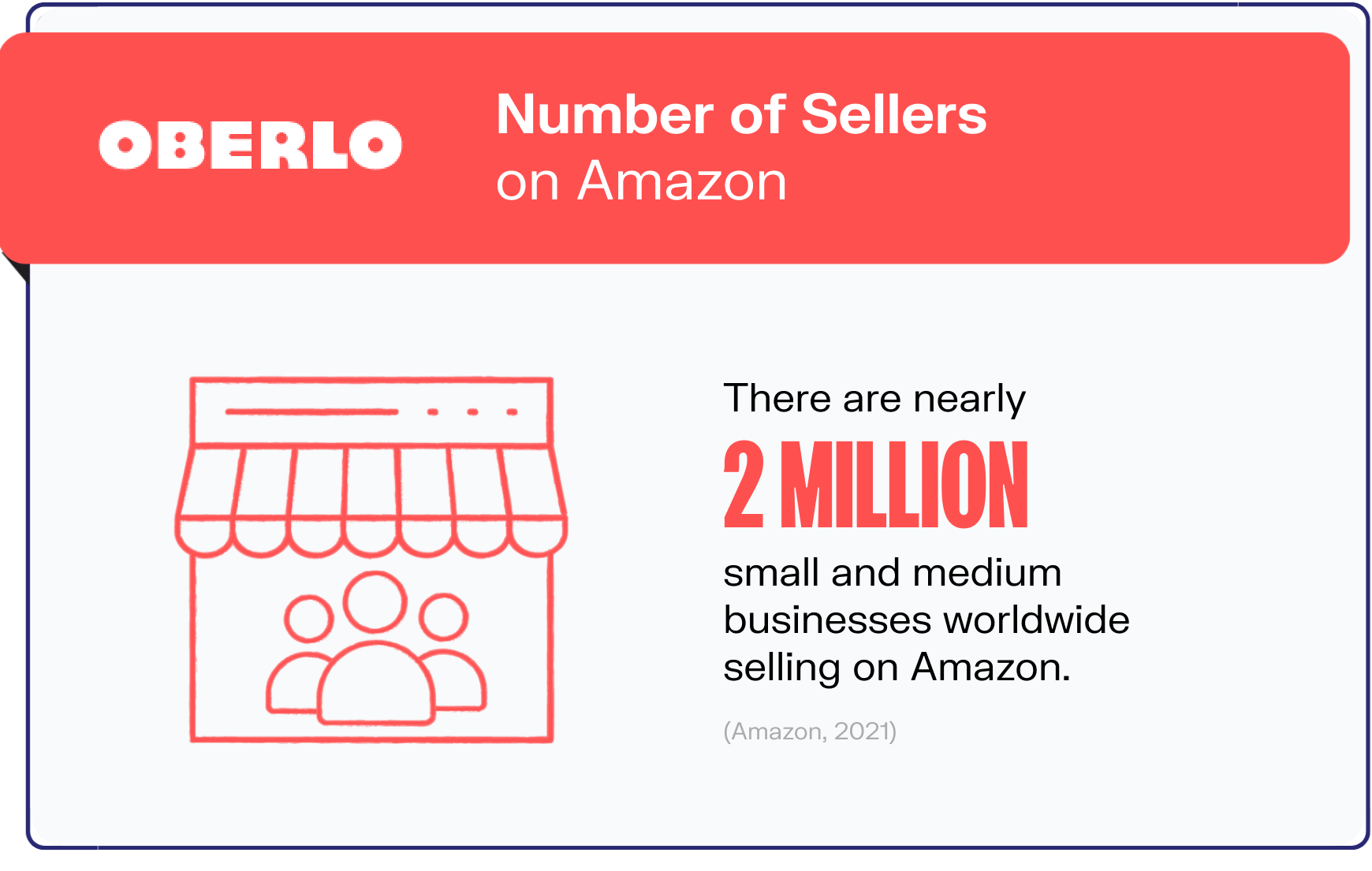
As one of the top online marketplaces worldwide in terms of gross merchandise value, it’s no wonder businesses are flocking to Amazon to sell. According to a recent report by Amazon, there are nearly two million small and medium-sized businesses operating on its platform (Amazon, 2021). This is defined as businesses that have fewer than 1,000 employees and annual revenues of up to $1 billion.
The number of small businesses selling on Amazon is growing. In fact, the same report states that the majority of products sold on Amazon are from small and medium-sized businesses. Sales have also increased for Amazon sellers. From September 2020 to August 2021, the average US seller on Amazon brought in $200,000 in sales. This is 14.3% more than the $175,000 earned in the previous 12-month period.
Amazon is actively trying to attract more sellers to join its platform, and this is evidenced by the large amount of resources it has for businesses. At last count, there are over 3,000 seller courses available for brands to take.
10. Buyers Visit Amazon for Inspiration

The latest Amazon statistics show that businesses aren’t the only ones turning to the popular online marketplace. Results from a survey show that more than half (56%) of consumers start their buyer’s journey on Amazon (Feedvisor, 2022).
Understanding the customer’s journey map helps online brands and retailers develop their strategies accordingly. If online retailers know that a big chunk of people are going online for inspiration when they don’t yet have a specific product in mind for purchase, they have the potential to influence the buyers.
Amazon remains an immensely popular first touchpoint for online shoppers without a product in mind for purchase. It’s the go-to place for shoppers and even ranks ahead of Google, the world’s largest search engine—21% of shoppers say they begin their buyer’s journey on Google.
Nearly three out of every four (72%) shoppers also opt to check product reviews on Amazon. In comparison, 32% say they do so on Google. With customer reviews ranking among the top reasons people shop online, this statistic certainly highlights the prowess of Amazon to attract potential shoppers.
Conclusion
After taking a look at these Amazon statistics, it’s safe to say that Amazon is here to stay. It’s a platform that’s full of opportunities for sellers from every industry. Take these Amazon statistics to develop a comprehensive understanding of the platform to have the tools necessary to maximize your presence on the Amazon marketplace in the coming years.

Summary: Amazon Statistics 2023
- Amazon’s app is the second-most popular shopping app in the US, used by 98 million users every month (Statista, 2021).
- Customers trust Amazon. 87% of buyers agree that they are more likely to buy products from Amazon than other ecommerce sites (Feedvisor, 2022).
- There are 168 million Amazon Prime subscribers in the US (CIRP Amazon, 2022).
- Amazon brought in $125.6 billion in sales revenue in the fourth quarter of 2020 (Amazon, 2021).
- Nearly one-third of SMB businesses on Amazon sell products in the home and kitchen category, making it the most popular category on the marketplace (Jungle Scout, 2022).
- 82% of Amazon buyers say price is an important factor to consider when shopping on the platform (Statista, 2019).
- 67% of Amazon Shoppers prefer to shop using their desktop computer or laptop (CPC Strategy, 2018).
- On average, small- and medium-sized businesses (SMBs) located in the US sell more than 4,000 items per minute (Amazon, 2019).
- There are nearly 2 million small and medium businesses worldwide selling on Amazon (Amazon, 2021).
- 56% of consumers start their buyer’s journey on Amazon (Feedvisor, 2022).



Want to Learn More?
- What is ePacket? Everything You Need to Know About Shipping, Delivery, and Tracking
- How to Start an Online Store: Kickstart Your Ecommerce Journey
- Ecommerce SEO: 8 Tips to Help Your Online Store Rank Better
- How to Make Money on YouTube: 5 Top Tips
- Product Description: 8 Tips to Write an Epic One
Is there anything else you’d like to know about Amazon statistics and wish was included in this article? Let us know in the comments below!
